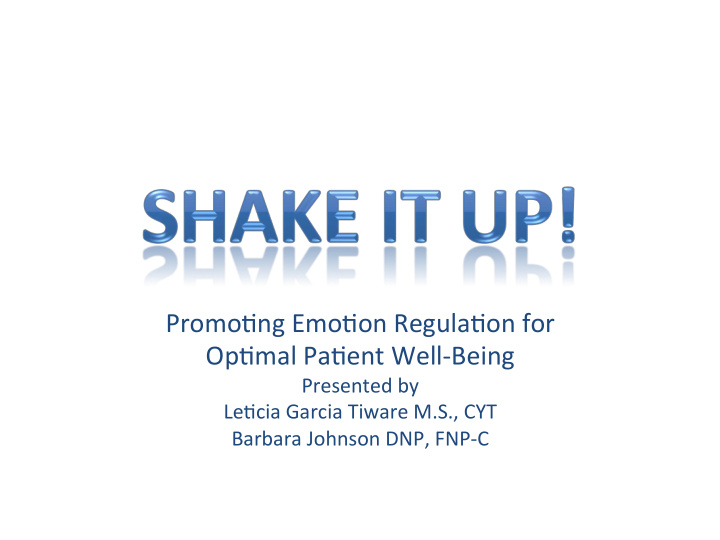



Promo%ng Emo%on Regula%on for Op%mal Pa%ent Well-Being Presented by Le%cia Garcia Tiware M.S., CYT Barbara Johnson DNP, FNP-C
Emo%on Regula%on Image obtained from: hMp://www.ganneM-cdn.com
Allosta%c load McEwen B.S. (2000)
The Body Under Stress Image obtained from: hMp://www.stress.org/daily-life/
Preven%on & Interven%on Smart, C.M., Segalowitz, S.J., Mulligan, B.P., Koudys, Image obtained from www.form-idea.com J. & Gawryluk, J.R. (2016).
Mindfulness Mindfulness Based Stress Reduc%on hMp://www.livemindfully.co.uk/about-mindfulness/
Medita-on Image obtained from www.elephantjournal.com
Breathing Prac-ces (Pranayama) Controlled Breathing Prac%ces Image from TwiMer via Cheryle Paylor
Mindfulness Play-Based Approach to Emo%on Regula%on By Le%cia Garcia www.embodyplayoga.com
Stress Response of the Autonomic Nervous System Calm/At Ease Trembling Heart Rate Increase Unstructured Muscular Tension Movement Emo%on Pupils Dilate Survival Discharge Regula%on Noisemaking/ Energy Diges%on Stops Crying Chest Breathing Fight/ Flight/ Freeze
Sympathe%c: Fight/Flight
Trembling Response • In the wild: – hMps://www.youtube.com/watch? v=bPFbXdSGSkc • In Children: Excitement and Tantrum – hMps://www.youtube.com/watch? v=VSFnmM12LOQ
Okay, Let’s Play!
Conclusion There are many ways to help pa%ents of all ages with emo%on regula%on: 1. Empathe%c listening 2. Playful movement 3. Breath/Vocaliza%on 4. Self care for op%mal co-regula%on Emo%on regula%on skills promote a life%me of health and wellbeing.
References: Balasubramaniam, M., Telles, S. & Doraiswamy, M. (2013). Yoga on our minds: a systema%c review of yoga for neuropsychiatric disorders. Psychiatry. hMp://dx.doi.org/10.3389/fpsyt.2012.00117. Brown, R.P., Gerbarg, P.L., Muench, F. (2013). Breathing Prac%ces for Treatment of Psychiatric and Stress-Related Medical Condi%ons. Psychiatr Clin N Am 36, 121–140. hMp://dx.doi.org/10.1016/j.psc.2013.01.001 Emerson, R.J. (2010). Homeostasis and Adap%ve Responses to Stressors. In L.E. Copstead & J.L. Banasik Editor (4 th Ed.), Pathophysiology p.14-24. St. Louis, Saunders Elsevier. Glaser, R. & Kiecolt-Glaser, J.K. (2005). Stress-Induced Immune Dysfunc%on: Implica%ons for health. Nature Reviews Immunology. 5, 243-251. doi:10.1038/ nri1571 Macy, R.J., Jones, E., Graham, L.M. and Roach, L. (2015). Yoga for trauma and related mental health problems: A meta-review with clinical and service recommenda%ons. Trauma,Violence & Abuse, December 9, 2015 1524838015620834, 1-23.
McEwen B.S. (2000). Allostasis and Allosta%c Load: Implica%ons for neuropsychopharmacology. Neuropsychopharmacology, 22 (2). 108 – 124. McEwen, B. (2006). The Protec%ve and Damaging Effects of Stress Mediators: Central Role of the Brain. Dialogues in Clinical Neuroscience. 8(4). Raub, J.A. (2002). Psychophysioilogic Effects of Hatha Yoga on Musculoskeletal and Cardiopulmonary Func%on: A Literature Review. The Journal of Alterna%ve and Complementary Medicine. 8 (6), p. 797 – 812. Ross, A. & Thomas, S. (2010). The health benefits of yoga and exercise: A review of comparison studies. The Journal of Alterna%ve and Complementary medicine,16 (1), 3-12. doi:10.1089=acm.2009.0044 Smart, C. M., Segalowitz, S. J., Mulligan, B. P., Koudys, J., & Gawryluk, J. R. (2016). Mindfulness training for older adults with subjec%ve cogni%ve decline: Results from a pilot randomized controlled trial. Journal of Alzheimer’s Disease.
Recommend
More recommend